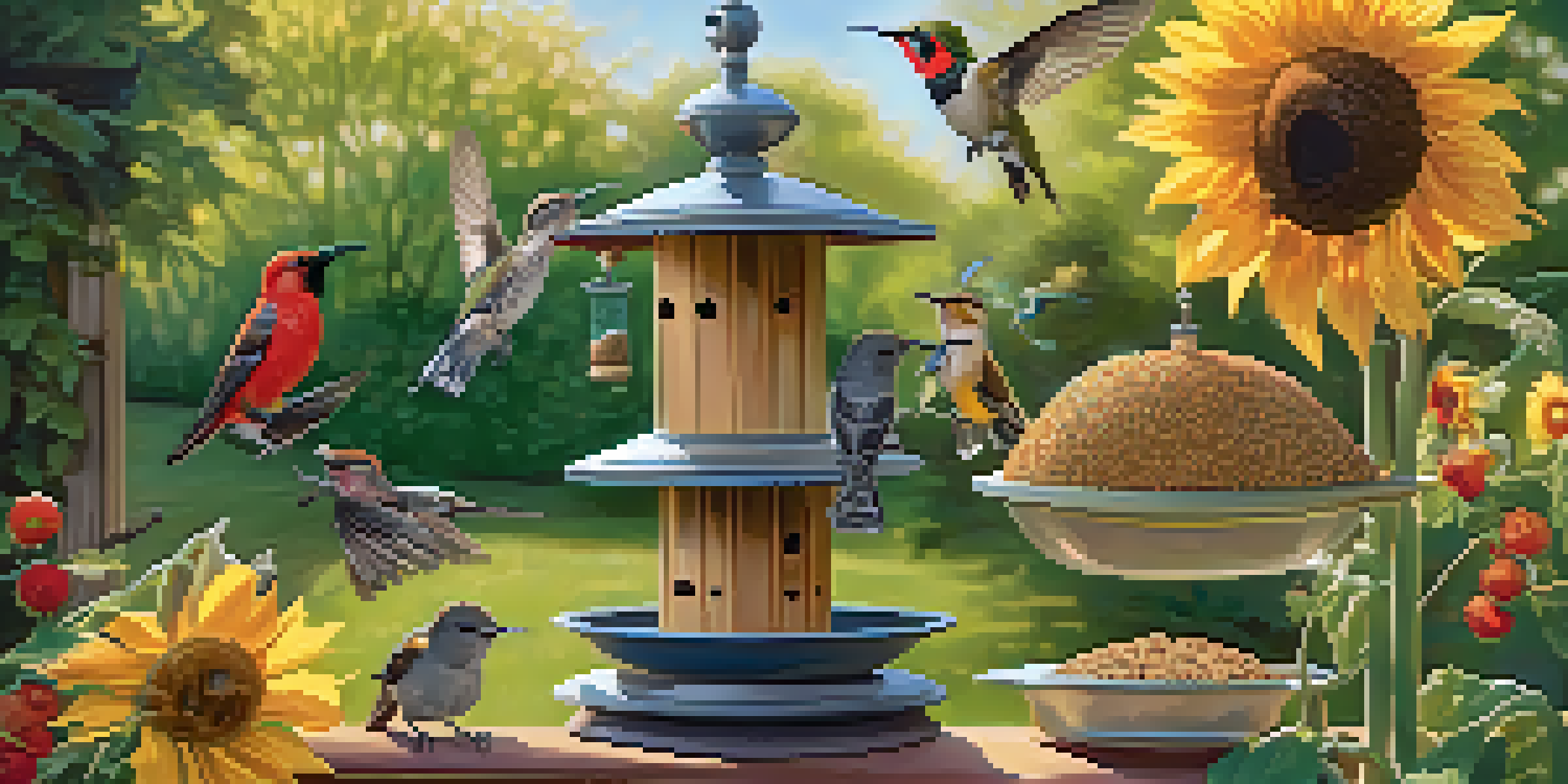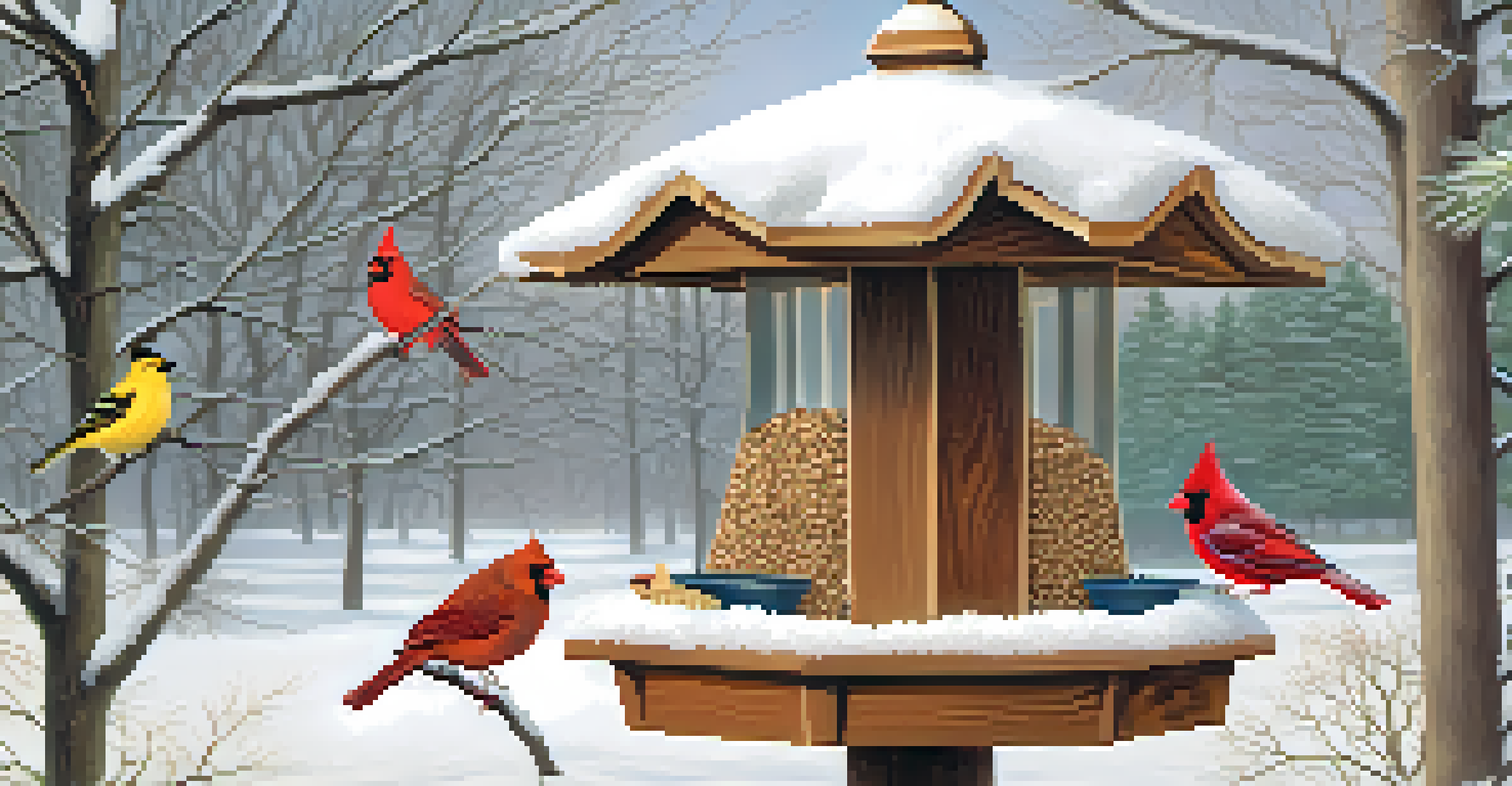Understanding the Nutritional Needs of Backyard Birds

Why Nutrition is Vital for Backyard Birds
Just like us, birds need a balanced diet to thrive. Nutrition plays a critical role in their health, helping them maintain energy levels and support their immune systems. By understanding their dietary requirements, we can attract more birds to our backyards and promote their well-being.
The love for all living creatures is the most noble attribute of man.
Birds require a mix of proteins, fats, carbohydrates, vitamins, and minerals. Each species has unique nutritional needs, which are influenced by factors like their size, habitat, and life stage. For example, young birds need more protein for growth, while adult birds may require more fat during migration.
Providing the right foods not only benefits the birds but also enhances your backyard experience. Watching healthy, vibrant birds flock to your feeders can be a rewarding hobby, connecting you with nature and encouraging biodiversity in your local ecosystem.
Understanding Different Bird Species and Their Diets
Different bird species have varying diets that reflect their natural foraging habits. For instance, seed-eating birds, like finches and sparrows, thrive on sunflower seeds, millet, and safflower. On the other hand, insectivorous birds, such as warblers and flycatchers, prefer protein-rich insects and larvae.

Hummingbirds are another fascinating example; they require a diet high in nectar. Offering a sugar-water solution mimics their natural food source, but it's essential to avoid artificial sweeteners or food coloring, which can harm them.
Nutrition is Key for Birds' Health
Providing a balanced diet helps backyard birds maintain energy levels, support their immune systems, and thrive in their environment.
By learning about the specific needs of the birds in your area, you can tailor your feeding practices. This enables you to create an inviting environment where various species can find the nourishment they need.
Essential Foods for Attracting Backyard Birds
To attract a diverse range of birds to your backyard, you should offer a variety of foods. Seeds are a staple, but it's also beneficial to include nuts, fruits, and suet. For example, placing a peanut feeder can attract woodpeckers and nuthatches, while a berry bush can draw in thrushes and mockingbirds.
In every walk with nature, one receives far more than he seeks.
Offering a mix of food types not only caters to different species but also encourages birds to visit your yard throughout the year. Additionally, try incorporating a water source; a birdbath can provide hydration and a place for birds to clean their feathers.
Remember, the quality of the food matters. Fresh and clean food will attract more birds, while spoiled or moldy offerings can deter them and even pose health risks.
Seasonal Dietary Changes in Backyard Birds
Birds' nutritional needs can vary significantly with the seasons. In spring and summer, many birds focus on feeding their young, which requires a protein-rich diet. During this time, offering insects or high-protein seeds can help support their breeding efforts.
As autumn approaches, birds begin to stock up on energy for migration. High-fat foods, such as sunflower seeds and suet, become crucial during this period. Providing these foods can help ensure that birds have the necessary energy reserves to travel long distances.
Tailor Foods to Bird Species Needs
Understanding the dietary preferences of different bird species allows you to create an inviting backyard that meets their nutritional requirements.
In winter, when natural food sources are scarce, birds may rely heavily on backyard feeders. Maintaining a consistent feeding schedule and providing high-calorie foods can make a significant difference in their survival during colder months.
Avoiding Harmful Foods for Backyard Birds
While it’s important to know what to feed birds, it’s equally crucial to understand what to avoid. Certain foods can be harmful or even deadly to backyard birds. For instance, avocados, chocolate, and caffeine are toxic to many bird species, so it's best to steer clear of these.
Additionally, bread, while often given as a treat, lacks essential nutrients and can lead to health issues. Instead, opt for healthier alternatives like birdseed or fruits that offer better nutritional value.
Educating yourself about harmful foods ensures that your feeding practices contribute positively to the birds' health. This knowledge not only protects them but also enhances your role as a responsible backyard bird enthusiast.
The Role of Bird Feeders in Nutrition
Bird feeders serve as a vital source of nutrition for backyard birds, especially in urban areas where natural food sources may be limited. By strategically placing feeders, you can provide a reliable and safe food supply that attracts a variety of species. Different feeders cater to different birds, from tube feeders for small seeds to platform feeders for larger foods.
It's essential to keep feeders clean and filled to maintain healthy bird populations. Regularly cleaning feeders helps prevent the spread of disease, while replenishing food ensures that birds return frequently. A well-maintained feeder can become a focal point of your backyard, providing hours of birdwatching enjoyment.
Create a Safe, Bird-Friendly Habitat
Incorporating native plants and minimizing chemicals enhances your backyard, making it a welcoming space for birds while promoting biodiversity.
Moreover, observing how birds interact with feeders can provide insight into their feeding habits and preferences. This knowledge allows you to adapt your feeding strategies to better meet their needs, creating a more inviting habitat.
Creating a Bird-Friendly Environment in Your Backyard
A bird-friendly backyard goes beyond just providing food; it involves creating a welcoming habitat. Incorporating native plants can significantly benefit local birds by offering natural food sources and nesting sites. Native plants are adapted to the local environment and often attract insects, which are food for many bird species.
In addition to plants, consider adding features like birdhouses, perches, and shrubs for shelter. These elements provide birds with safety and comfort, encouraging them to linger in your yard. A diverse landscape with varied heights and textures creates an inviting space for birds to explore.

Finally, minimizing the use of pesticides and chemicals helps protect the birds and their food sources. By fostering a safe and sustainable environment, you contribute to the well-being of not just the birds, but the entire ecosystem.